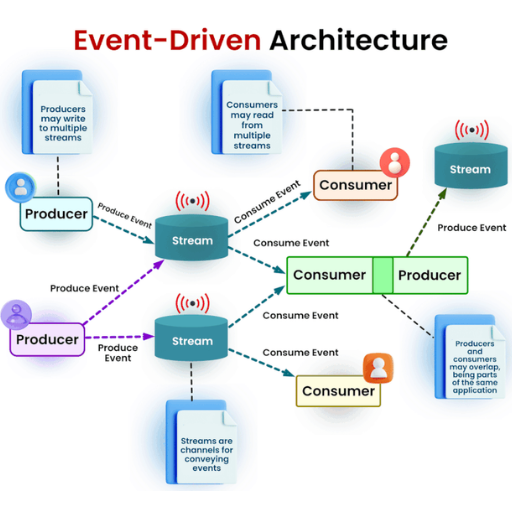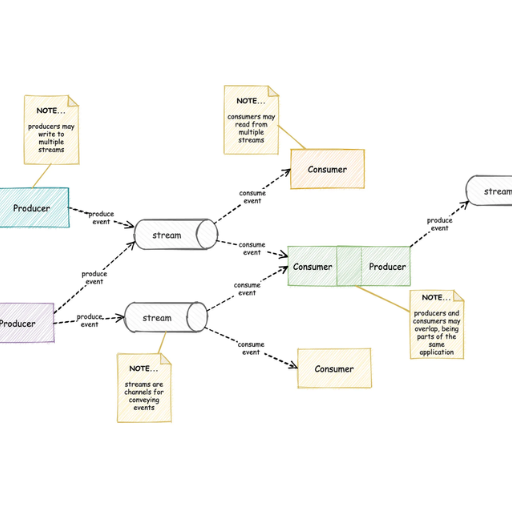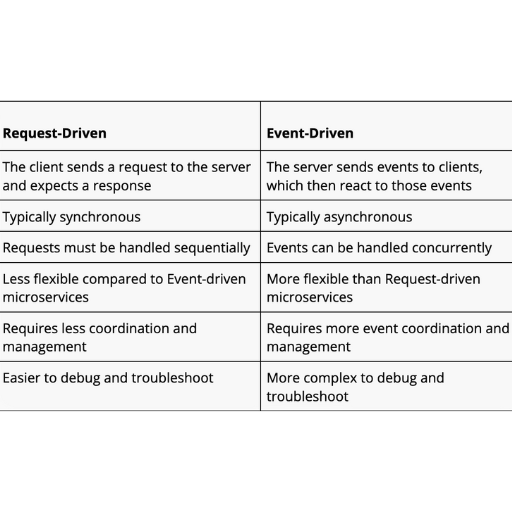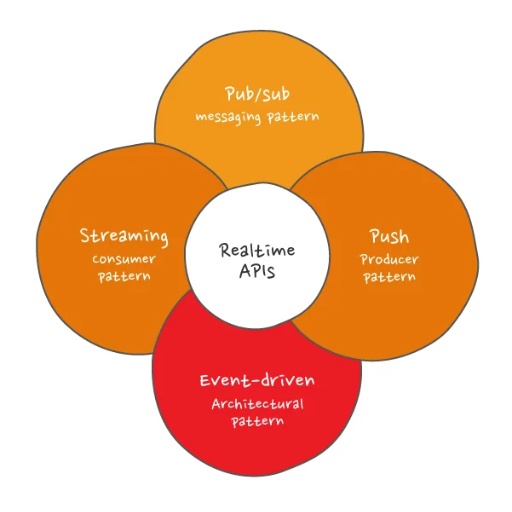Unleashing the Power of Event-Driven Architecture: A Comprehensive Guide to EDA Use Cases and Advantages
Systems today have a unique approach to event, process, and interaction handling - something known as Event-Driven Architecture (EDA) - which, in contrast, makes use of real-time events for an organization's communication. This enables breathtaking agility with architectures that are adaptive towards changing business challenges. In this article, we’ll attempt to present everything about event-driven architecture, including its tenets, case-studies, and why it is crucial for modern systems.
To start with, we will cover the fundamentals of EDA concerning how system events dictate processes, so that readers understand the importance of Events in workflows. Then, the conversation will expand to event architecture practical applications, demonstrating how various organizations leverage EDA for rapid reaction times, better customer satisfaction, and efficient functioning within and outside the corporation. To conclude, we look at the provided value from the EDA perspective in contrast to other options, discussing most beneficial scalability, flexibility, and integration features, which proves the necessity of supporting this business decision. No matter if you are an expert engineer or a business leader looking for cutting edge techniques, this detailed article will give you the needed information on EDA exploitation.
What is Event-Driven Architecture (EDA) and How Does it Work?

Event-Driven Architecture (EDA) is a form of architectural design where systems interact through the creation, identification, and response to events. An event denotes the 'what' – a relatively important happening within the system usually captured by a user activity, an update of a system, or a data entry from some other source. The main building blocks of EDA are producers of events, brokers of events, and consumers of events. Events get produced, brokers transmit them, and consumers respond to them whether they choose to do so instantly or within a reasonable period. This loosely coupled arrangement means that systems can freely function without reliance on one another so they are readily scalable, flexible, and efficient in resource allocation for erratic workloads or unsolicited information streams.
Understanding the core principles of event-driven systems
The principles on which event-driven systems are established focus on responsiveness, scaling, and modularity. When considering the event paradigm, the system's architecture revolves around event production, event distribution, and event consumption. This model guarantees loose coupling of systems, meaning the producers are independent of their consumers – they can develop and scale on their own. Brokers facilitate events as they serve as a terminal for event registration and act as routers of information channeling the information relay into real-time. It permits the adaptation of response to edge cases in high-throughput situations, making it beneficial for modern agile applications.
Key components: Event producers, consumers, and brokers
- Event Producers
Within an organization, at their core, event producers are responsible for organizing events. They mostly capture them without caring who will receive them later. Take for example a service that publishes notifications, a sensor in an IoT device or an application that records user activities. Their responsibility is to make sure the relevant information is published to the event broker as quickly as possible.
- Event Consumers
The described role is chosen by people who work with services or systems that deal with a particular event subscription and processing, in our case, the events that have been produced. Brokers make it possible for them to listen to event streams or certain topics, enabling automation. Consumers usually carry out database updates, invoke workflows, and do other analytical processes. Thanks to producers, consumers can scale and adjust to new challenges without being dependent on the systems above them.
- Brokers
These are the main executives that keep everything running. Brokers are the organizers that sit in between the producers and consumers and manage how events flow from one party to the other. They guarantee the proper routing of events, temporary or persistent storage of events, scalability, and reliability. Some of them are well-known like Apache Kafka, RabbitMQ, or AWS SQS. Their work allows the system to function properly in situations where events and data flow are very high by buffering events to preserve their order and data consistency.
The role of event processing in EDA
Event processing within an Event Driven Architecture (EDA) is highly salient as it allows systems to react to changes and actions in real-time. It revolves around the detection and communication of a system's actions while also taking into consideration the coordination between its system components. Better responsiveness, scalability, agility, and restructurability are achieved within applications. Efficient event processing allows quick business modifications and seamless user experiences as workflows are optimized.
Why Should You Consider Using an Event-Driven Architecture?

The advantages offered by event-driven architecture (EDA) are remarkable, especially in modern applications. Firms looking to improve business processes with evolving technology can rely on EDA since it increases reliability by isolating failures for easy recovery. With EDA, systems can respond to events instantly, which improves agility and adaptability in dynamic environments. The enhanced decoupling of components increases scalability, allowing individual services to change without affecting the entire system. Further adding to the decision-making, EDA enables real-time data processing, which speeds up the decision-making process, resulting in improved user experiences.
Benefits of event-driven architecture for modern applications
From my perspective, the most important advantages of event-driven architecture (EDA) in modern applications are its scalability, responsiveness, and flexibility. EDA enables applications to effortlessly manage increases in data or traffic and serve them effortlessly, irrespective of the performance metrics. Its asynchronous character realizes quick user service as services can react and attend to an event in progress. Moreover, I appreciate how EDA promotes modularity, where distinct services can change or scale independently, minimizing service interruption and speeding up development cycles. This structure is particularly helpful for companies that have to quickly respond to shifts in the market and technology.
Achieving Loose Coupling and Scalability with EDA
Event-Driven Architecture (EDA) fosters loose coupling since services communicate using events instead of through direct dependencies. This approach enables the decoupling of an event’s producer from its consumers, allowing different components to function on their own. Since there are weaker interdependencies, system updates become simpler because changes to one service do not affect others, which in turn enhances the system architecture’s flexibility and dynamism.
In EDA, loose coupling is achieved by its capacity to process enormous numbers of events concurrently for scalability. With the aid of message brokers or event streams, systems can distribute event processing tasks across several services, making it possible for businesses to respond to varying demands while allowing horizontal service scaling and support for complex, high volume systems. All in all, the modularity and scalability of EDA guarantees its efficacy in high change environments.
Enhancing Fault Tolerance and Real-Time Capabilities
Improving fault tolerance within the context of Event-Driven Architecture (EDA) generally involves methods like redundancy, retry strategies, and distributed systems. EDA mitigates the risk of failure from a single component by distributing work across several autonomous services. Implementing event queues and fallback strategies helps to mitigate error impacts while ensuring no data is lost.
The use of asynchronous communication and event streams accomplishes real-time capabilities, quarter latency, and allows for rapid data processing. Even under high loads, Apache Kafka and RabbitMQ are essential to providing real-time information and continuity. These characteristics guarantee that EDA remains agile, responsive and capable of handling advanced modern applications effortlessly.
How Does Event-Driven Architecture Compare to Microservices?

Both Event-Driven Architecture (EDA) and microservices are ways of looking at software design. EDA looks more towards decoupling systems through events and real-time communication while microservices lean more towards breaking up applications into independent services that communicate by APIs. EDA is most beneficial for processes that are asynchronous and need high levels of responsiveness and scalability. Microservices, on the other hand, depend on synchronous communication where direct service-to-service interaction is a necessity. When EDA is combined with microservices, the system's flexibility, scalability, and resilience are increased due to the event-driven, loosely coupled workflows between microservices.
Exploring the relationship between EDA and microservices
Both Event-Driven Architecture (EDA) and microservices deal with disparate yet interrelated problems in the development of contemporary applications. EDA attempts to drive a wedge between components of systems by decoupling system components through the use of events, which increases asynchronous communication and scalability for the systems. Microservices, however, break down an application into smaller, deployable services which are each responsible for a single type of business function.
The integration of these two paradigms offers strong system designs. The EDA is greatly enriched because microservices are enabled to emit and consume events to interact with other independent components. This enhancement reduces the need of having to depend heavily on synchronous communication, which in turn increases the resiliency of the system to bottlenecks and improves fault tolerance. For example, an order processing system can publish events such as ‘Order Created’ and other microservices such as inventory service or payment service can subscribe to the events without having to deal with direct dependencies. This approach increases the level of agility because it is easier to modify, add, or scale individual components of the system by separation of concerns.
Nonetheless, there is developing and managing an event schema, and with it, a host of new problems like complexity of the overall system and monitoring arise. Having proper event contracting, investing in observability, and using tools such as Kafka or RabbitMQ helps mitigate these problems and results in an integrated resilient and scalable architecture using microservices and EDA.
Combining event-driven and microservices architectures
The blend of event-driven and microservice architectures enables me to create systems that are responsive, decoupled, and scalable. Utilizing event-driven techniques, I make certain that services can communicate in an asynchronous way, which makes it easier to handle faults and respond to changes in real time. Kafka and RabbitMQ are among the best tools for event stream management, and investing in observability means I can monitor and resolve issues quickly. My approach makes the execution of business processes across distributed services much easier, allowing effortless scaling in response to changeable demands.
Advantages of Event-Driven Microservices
- Improved Scalability
An event-driven architecture is capable of decoupling certain services, enabling independent scaling based on demand. This design can also manage traffic spikes thanks to tools like Kafka that provide reliable message processing by supporting a million messages per second.
- Real Time Data Processing
Microservices with an event-driven architecture pattern enable real-time workflows because of the asynchronous communication capability. Such systems can instantly respond to an event via technologies like RabbitMQ that can help with latency by providing a timely response.
- Enhanced Fault Tolerance
One advantage of event-based systems is that failing in one service will not disrupt the entire application. For example, event queues can act as temporary buffers enabling retries and alternate processing paths. Setting up Kafka with replication factor parameters ensures data availability even with node failures.
- Reduced Inter Service Dependencies
Event publishing disaster producers and consumers so that direct dependencies are minimized. The benefits gained from this alteration, maintenance flexibility while changing one service, do not impact other services that are connected via an event bus.
- Ease of Integration
Systems integration is made easy with the addition of new external systems and services due to the event-driven designs. This is made possible with webhooks and API gateways, event streaming frameworks that do not couple systems.
- Auditability and Observability
The event logs in the system provide the aid needed with debugging alongside auditing the system for its changes.
Integrating observability tools such as Prometheus or Grafana to monitor event streams enhances operations visibility even further.
What Challenges Might You Face When Adopting Event-Driven Architecture?

Shifting towards event-driven architecture (EDA) comes with its own set of difficulties, especially when referring to the amount of complexity and operational overhead involved. For one, managing distributed systems comes with its own set of challenges, such as guaranteeing message delivery, as well as failure management strategies. While many issues, such as data consistency and event sequencing can be quite difficult to handle, with the additional burden of multiple microservices trying to process the same events, there is an additional challenge of proper system observability, which becomes incredibly crucial but difficult to achieve due to the nature of asynchronous EDA. Small teams and organizations operate at a deficit of skill when it comes to managing event-streaming platforms, such as Kafka or RabbitMQ, which come with their documentation barriers and complicated learning curves.
Ensuring event ordering and consistency
To achieve the desired level of order and consistency in an event-driven architecture, one needs to think it through quite a bit. First, I would apply partitioning techniques within event-streaming systems such as Kafka, using partitions keyed by unique identifiers so that order is maintained for specific event types. Idempotency ensures that system integrity is maintained regardless of duplicate events. Furthermore, applying appropriate versioning and schema evolution techniques helps consistency over time with the necessary changes. To make sure the system works properly, I would set up monitoring systems that would help rectify out-of-order events.
Managing complexity in distributed systems
To manage the intricacies in distributed systems, purposeful steps need to be taken to ensure reliability and scalability. First, I would focus on systems boundary definition using microservices architecture. The microservice approach ensures services are cohesive while being loosely coupled, which makes scaling and debugging easier. Second, having strong monitoring and observability tools helps with the system's health and with failures. For robust failure, health monitoring tools like Prometheus or Grafana, which provide metrics and dashboards, can do wonders. Finally, I would minimize human effort in testing, deployment, and scaling by automating these activities to reduce possible errors. All these measures put in place assist in streamlining operations while managing the complexity of distributed systems.
Addressing performance and latency concerns
Reducing latency and increasing performance are core tasks in a distributed system. You can tackle these issues by first finding the bottlenecks through detailed monitoring and profiling tools. For general optimization, ensure efficient database query indexing and use appropriate caching mechanisms, like Redis or Memcached, to store frequently used data nearer to the user for faster response times.
Another core action is network optimization. To offload servers, the use of content delivery networks (CDN) reduces latency by serving content from an edge location relative to the user. Payload size can also be reduced through compression, and round-trip responsiveness is improved by API optimization, as well as through the use of HTTP/2. Proper load balancing ensures the distribution of traffic across servers so that every node is equally used, thereby avoiding congestion in a specific node.
The use of autoscaling policies and some degree of asynchronous processing also considerably improve performance during traffic spikes while incurring the least possible latency. These processes combined are best used to make sure a distributed system is responsive and efficient.
What Are Some Real-World Examples of Successful Event-Driven Architectures?

Different sectors utilize event-driven architecture to improve scale, responsiveness, and behavioral effectiveness. Amazon, for instance, leverages event-driven systems to process modifications like inventory updates, order statuses, alongside personalized recommendations, all in real time. Similarly, Uber employs this architecture to manage real-time interactions between passengers and drivers such as ride request submissions, location tracking, and payments. Event-driven frameworks are also widely used by financial institutions for fraud monitoring, where events such as unusual transactions instantly trigger alerts alongside automated responses. These instances mark how business organizations can drive change in complex and demanding environments through event-driven systems.
Case studies from leading tech companies
To improve user recommendations and provide uninterrupted streaming services, Netflix leverages event-driven architecture to process data in real time. By using distributed systems, Netflix can process billions of events every day without any hassle.
Amazon uses event-driven architecture frameworks to facilitate the functioning of their e-commerce website. With millions of transactions happening at the same time, Amazon can manage inventory and give users shopping recommendations without compromising system performance.
Uber's ride-hailing services operate on the principles of event-driven architecture and so enable real-time communication between riders and drivers. With streams of events processing instantly, Uber's platform can provide accurate navigation, efficient routing, and prompt response to user actions, which facilitates enhanced experience for everyone involved.
Event-driven architecture in cloud-native applications
Cloud-native applications need an efficient way to accommodate scalability and flexibility, and event-driven architecture delivers by providing real-time system responsiveness. My understanding is that it splits components into an event producer and consumer, allowing communication through pub/sub and message queues. This method is best suited for cloud environments with elastic resource provisioning because it caters to dynamic workloads. With this architecture, applications are more responsive and achieve higher fault tolerance, which is a necessity in modern distributed systems.
EDA Success Stories Across Different Industries
- Finance
The financial industry has embraced Event-Driven Architecture (EDA) technology, which helps with improving fraud detection and customer services. For instance, payment processing systems use EDA to identify unusual transaction activities in real time and subsequently issue alarms. This level of service not only prevents fraud but also allows for hassle-free payment processing. In addition, EDA is used by stock trading platforms to analyze market data and make decisions about trades at supersonic speeds.
- E-Commerce
The largest e-commerce companies implement EDA for order management, inventory refreshing, and customer personalization services. When a customer makes a purchase, an order confirmation, inventory update, and shipping notification are all sent out simultaneously. This event-driven technique allows for maximized efficiency and scalability, particularly during heavy shopping surges.
- Healthcare
The healthcare sector employs EDA technology to enhance patient monitoring and care systems. For example, real-time health data collected via wearable devices and IoT sensors activates (i) emergency intervention notifications or (ii) medication reminders. EDA in hospitals enables improved dynamic scheduling, resource management, and operational patient care.
These examples illustrate the evolution of industry processes due to Event Driven Architecture technology by enabling the ability to respond to continuously changing requirements in real time, scale, and adapt. This architecture continues to enable better innovations and efficiency across countless sectors.
References
Frequently Asked Questions (FAQ)
Q: What is event-driven architecture and how does it work?
A: Event-driven architecture (EDA) is a software design pattern where the flow of the program is determined by events such as user actions, sensor outputs, or messages from other programs. It works by allowing components to react to events as they occur, with an event producer sending messages to an event broker, which then distributes these events to interested event consumers. This architecture enables real-time processing, loose coupling between components, and scalability in complex systems.
Q: What are the key advantages of event-driven architecture?
A: The advantages of event-driven architecture include improved scalability, enhanced responsiveness, better fault tolerance, and increased flexibility. EDA promotes loose coupling between components, allowing for easier system updates and maintenance. It also enables real-time event processing, which is crucial for applications requiring immediate responses. Additionally, event-driven architecture provides better resource utilization and supports complex event processing for advanced analytics and decision-making.
Q: How does event-driven architecture relate to microservices?
A: Event-driven architecture and microservices often go hand in hand. When combining EDA with microservices, each microservice can act as an event producer or consumer, communicating asynchronously through events. This approach enhances the modularity and scalability of microservices-based systems. EDA promotes loose coupling between microservices, allowing them to evolve independently while maintaining system-wide consistency through event streaming.
Q: What are some common use cases for event-driven architecture?
A: Event-driven architecture use cases are diverse and include real-time analytics, IoT device management, financial transaction processing, and customer experience personalization. It's particularly useful in scenarios requiring real-time event processing, such as fraud detection systems, logistics and supply chain management, and social media monitoring. EDA is also commonly used in e-commerce platforms for inventory updates, order processing, and recommendation engines.
Q: How does event-driven architecture handle transactions?
A: In event-driven architecture, transactions are often handled through patterns like event sourcing and CQRS (Command Query Responsibility Segregation). Instead of updating a single data store directly, changes are recorded as a series of events. These events can be replayed to reconstruct the current state or to roll back to a previous state if needed. This approach provides a complete audit trail of all transactions and allows for complex event processing to derive insights from transaction histories.
Q: What are the challenges of implementing event-driven architecture?
A: Challenges of implementing event-driven architecture include ensuring data consistency across distributed systems, managing event schema evolution, and handling event ordering and idempotency. Debugging can be more complex in EDA systems due to their asynchronous nature. Additionally, designing an effective event mesh or choosing the right event streaming platform (like Apache Kafka) can be challenging. Organizations may also face cultural shifts when moving from traditional request-response models to an event-driven approach.
Q: How does event-driven architecture enable real-time processing?
A: Event-driven architecture enables real-time processing by allowing systems to react to events as they occur, rather than relying on periodic polling or batch processing. When an event is sent, it can be immediately consumed and processed by interested components. This real-time event processing capability is crucial for applications that require instant reactions, such as stock trading platforms, IoT sensor networks, or live streaming services. EDA's asynchronous nature also allows for parallel processing of events, further enhancing real-time capabilities.
Q: What is an event broker, and what role does it play in event-driven architecture?
A: An event broker is a central component in event-driven architecture that acts as an intermediary between event producers and event consumers. It receives events from producers and distributes them to relevant consumers, often using publish-subscribe patterns. Event brokers, such as Apache Kafka or RabbitMQ, handle message queuing, event routing, and can provide features like event persistence and replay. They play a crucial role in ensuring reliable event delivery and decoupling producers from consumers in the system architecture.
Q: How does event-driven architecture improve system scalability?
A: Event-driven architecture improves system scalability by allowing components to be added or removed without directly impacting others. As events are decoupled from their processors, new event consumers can be easily added to handle increased load. EDA also supports horizontal scaling, where multiple instances of a component can process events in parallel. The asynchronous nature of event processing reduces system bottlenecks, allowing different parts of the system to scale independently based on their specific requirements.
Q: Can you explain the concept of event sourcing in event-driven architecture?
A: Event sourcing is a pattern often used in event-driven architecture where the state of a system is determined by a sequence of events rather than just the current state. All changes to the application state are stored as a sequence of events in an event store. These events can be replayed to reconstruct the system's state at any point in time. Event sourcing provides benefits such as complete auditability, the ability to reconstruct past states, and support for complex event processing. It's particularly useful in financial systems, version control systems, and any application requiring a detailed history of changes.